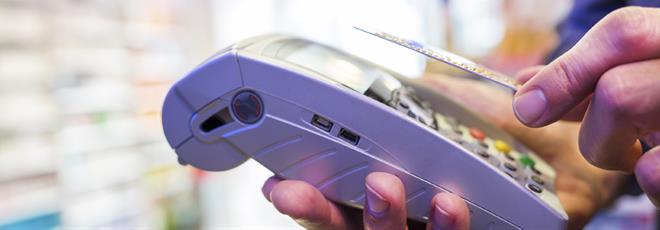EMV credit card chip technology in 8 FAQs
What does EMV stand for?
EMV is short for Europay, MasterCard, and Visa, the 1994 founders. It's a secure software for payments and commonly refers to a credit card with a smart chip.
The EMV standard is a security technology used worldwide for all payments done with credit, debit, and prepaid EMV smart cards.
The new chip on credit cards means payment security for over 11 billion cards in early 2022.
It can be used in three forms: contact, contactless, and mobile.
Let's discover why EMV chip cards conquer the world in 8 points.
#1. What is an EMV chip?
#2. Chip-and-PIN and Chip-and-signature. What's the difference?
#3. Why is EMV more secure?
#4. The meaning of the EMV liability shift (a strong motivation)
#5. The latest EMV deployment stats
#6. What are EMV's key features?
#7. The very tangible benefits
#8. EMV for mobile payments too
#1. What is an EMV card?
EMV cards use a smart chip instead of a mag stripe to store the data needed to process a transaction.
EMV® defines a suite of security standards for credit and debit card transactions. EMV can be used for NFC mobile payments as well.
They are also referred to as "EMV cards," "EMV smartcards", or "EMV credit cards," "chip and PIN cards," "Chip and signature cards," or even "IC cards" (for integrated circuit).
#2. What's the difference between chip and PIN and Chip and signature?
In both cases, the cards are EMV cards.
Most cards issued in the United States are chip and signature. The EMV payment process requires the cardholder to provide a signature to complete a transaction, just like credit cards traditionally have in the past.
Outside the United States, chip-and-PIN is more common. The PIN function requires a secret four-digit PIN code known only by the cardholder to validate the EMV payment. It is more secure.

In 2021, most ATMs and payment terminals outside the United States have been updated and can detect that your card is EMV compliant, that a PIN wasn't issued on your card, and validate the transaction.
Anyway, it's a good idea to travel with a chip card that offers both authentication methods and to carry more than one credit card.
#3. Why are EMV chip cards more secure?
EMV brings increased security and global interoperability to card and mobile payments, even in card-not-present payments, if coupled with a card reader or one-time password device.
The chip* on an EMV card can provide more sophisticated authentication than magnetic-stripe cards.
In other words, a fully operating computer system is embedded in every EMV card.
The chip is tamper-proof, making the card nearly impossible to clone.
With the former technology (the magstripe), invented in the '60s by IBM, a payment card became easy to duplicate.
#4. What does the EMV liability shift mean?
In the United States, the fraud liability shift (aka EMV liability shift) ran into effect in October 2015 for POS (Point Of Sale) devices.
The liability shift for outdoor Automatic Fuel Dispensers was planned for 1 October 2020.
However, upgrading to EMV is not a law per se.
But the rules defined by Express, Discover, MasterCard, and Visa (the EMV mandate) clearly state this:
The liability for card-present fraud (typically when you handle your card to the merchant in a store) can now fall on the card-issuing bank or the merchant if the EMV technology is not in place.
That was not the case before.
In other words: the burden of fraud is placed on the merchant side if the card is "swiped" (using the magstripe) instead of "dipped" (using the chip and doing an EMV transaction).
This happens for businesses with an EMV terminal if they don't use it properly and merchants who haven't upgraded to EMV yet.
At this point, you understand why merchants are motivated to upgrade their payment devices to accept the new cards and why Banks are issuing EMV chip cards.
Needless to say, the EMV migration is now full speed in the U.S.
In August 2015, the Reserve Bank of India (RBI) mandated banks to phase out the magstripe payment cards and migrate them to EMV chip cards. RBI set 31 December 2018 as the chip and PIN card migration deadline.
A transaction at the ATM may be declined due to a non-EMV TXN (TXN is short for a transaction). That means you don't have an EMV card, and you need to get one. This step follows RBI's guidelines for banks for non-EVM transactions.
The result?
#5. EMV deployment statistics
There are now over 10.81 billion EMV chip cards in circulation at the end of 2020. This is an increase of close to 10% over 2019.
In Q2 2021, according to information collected from American Express, Discover, JCB, Mastercard, UnionPay, and Visa, 88.55% of all chip card-present transactions in the world (both contact and contactless) - used EMV chip technology.
So, is the transition to EMV complete?
No, not yet in Asia and in the U.S.
More precisely, from July 2020 to June 2021, total EMV transactions were:
98.69% for Africa and the Middle East with 339m cards in circulation
82.92% for Asia with 6,88 billion cards
95.34% for Latin America, Canada, and the Caribbean with 1,02billion emv cards
99.56% for Europe zone 1 with 1,07 billion
96.97% for Europe zone 2 with 335m
77.52% for the United States with 1,16 billion
In the United States alone:
Over 12 months (July 2019 - June 2020 to July 2020 - June 2021), EMV card-present transactions increased from 67.84% to 77,52%, so +14,2%.

EMV fraud stats
That means EMV technology is working as planned.
See how EMV chip cards can reduce payment fraud in card-not-present fraud cases as well.
#6. How does EMV work?
The EMV chip
Why do the EMV specs explicitly request a smart chip inside each card?
For one reason - security.
A smart card chip is a small computer with a microprocessor, memory, and application software.
Unlike a magnetic stripe card, a smart card is tough to crack as it's been designed with security in mind.
It also contains a secure vault that holds unique keys specific to each card that protect your transactions.
A Unique Code for Each EMV Payment
EMV cards generate a unique code that your bank validates for each transaction, and the code cannot be re-used.
A fraudster couldn't make a transaction using a fake card with stolen data at an EMV terminal because it wouldn't generate the proper code.
Advanced Cryptography
EMV security relies on strong cryptography, which generates unique transaction codes that allow the terminal to authenticate the card.
This cryptography is built on private key infrastructure, meaning that only a personalized chip card with the cardholder's private key during manufacturing can generate a valid transaction.
SDA vs DDA
Card Authentication Methods (CAMs) were based on Static Data Authentication (SDA).
However, the world has moved on, and most payment cards shipped today feature the more sophisticated Dynamic Data Authentication (DDA) or Combined Data Authentication (CDA).
So what is DDA more precisely?
It's a protocol for checking that the EMV card is legitimate.
It's an offline authentication method (so without any network). It uses data from the card to allow the EMV terminal to authenticate the card.
The terminal (POS, for example) comes preloaded with keys. It will check complementary keys on the card for each transaction. It's excellent protection from certificate cloning and card skimming.
Visa and MasterCard have mandated migration to DDA on all EMV smartcards in Europe and Canada, which is becoming standard in the U.S.
EMV Software and Tokenization
EMV Tokenization is a new security standard recently defined by EMVCO to facilitate e-commerce.
Its goal is to secure Card on File payments, e.g., payments using customer card information already stored from a previous transaction.
The EMV tokenization process has been proven to reduce card rejection dramatically.
This slashes the potential loss of revenue when purchases cannot be completed.
This improves the user experience (and they won't go to the competition).
#7. What are EMV benefits?
Payment Security: EMV chip cut fraud by half in the U.S. in the first year.
EMV is one of the most secure forms of payment.
EMV is almost 100% effective in preventing face-to-face (in-store, aka card-present fraud) counterfeit card fraud.
When France migrated to EMV in 2005, card fraud nearly disappeared.
The case was replicated in the United Kingdom in 2012 (chip and PIN).
The U.S. began adoption in late 2015, and a study from the (U.S.) Federal Reserve issued in 2018 showed that the amount of card-present fraud in the country declined from $3.68 billion in 2015 to $1.91 billion in 2016.
It's a 48% decrease in ONE year.
Over three years and a half, it's a decrease of 87%, according to the June 2019 Visa report mentioned earlier.
Increased card spending
The tap-and-go convenience of a contactless EMV chip card will likely make it your customers' new favorite, leading to increased loyalty and spending on that card.
Adding contactless capacity has even generated a significant increase in contact transactions made with those cards.
Global interoperability of the EMV standard
EMV is the worldwide standard for payments. The technology's market penetration is growing worldwide, particularly the nearly 100% EMV compliance in portions of Europe and Canada.
Today, with magnetic-stripe cards, your customers may not be able to pay with their cards when they're traveling internationally.
In other words: Wherever EMV chip cardholders make purchases, they get reliability and convenience.
Strengthened customer relationships
Migrating to EMV is an opportunity to show your customers that you take their security seriously.

#8. EMV chip for mobile payments too
Contact EMV chip card.
Contact EMV offers the added security of the EMV chip, making it impossible to create counterfeit cards. Contact cards can be used in all EMV-capable POS payment terminals.
The card is inserted into the terminal. It stays there while the customer types a PIN or writes their signature.
Contactless (dual-interface) EMV card
Contactless is the level to go for convenient, future-proof, and secure technology.
A country-based contactless limit allows for payments using NFC without a PIN authorization.
The card is tapped against the POS terminal or waved in front.
Contactless is a safe option that aligns with social distancing guidance.
As reported by NFCW on 1 May 2020, the U.S. now has the most significant number of contactless cards of any market at 175m.
Mobile payment
With mobile EMV, the customer's account credentials are loaded directly onto an NFC-enabled cell phone or wearable device. This process is just as secure as a contactless EMV chip but with superior convenience and added opportunities.
The smartphone is tapped or waved at the POS terminal, like a contactless card.